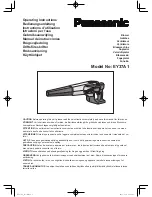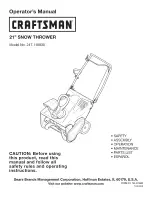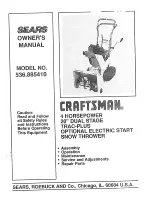
SB-7-622 Page 29
16 SETTING
IMPELLER END CLEARANCE
Refer to Figure 7-1, page 29. The gear end bearings are held in position by the force created by the wavy spring
(28) on the drive end and the bearing retainer (12) on the gear end. The interference fit between the shaft (H) and the
bearing inner race (E) keeps the shaft from moving axially.
End clearance adjustment of both impellers is controlled by adjustment of the bearing retainer (12). Tightening the
bearing retainer screws (10) moves the bearing to load the wavy spring (28), and the impeller is forced toward the drive
end. Relaxing the screws allows the wavy spring to return the impeller toward the gear end.
A. With impellers tight against the gear headplate, measure the distance (A) from the bearing outer race to the
gear headplate using a depth micrometer (see Figure 7-5, page 32).
B. Subtract 1/3 of the total end clearance from the value measured at point (A). This value is the amount of shim
(13) that should be placed between the retainer and the headplate at point (S).
C. Secure bearing retainer (12) with the correct amount of shim, to the headplate using capscrews (10). Torque
capscrews to the specifications given in Figure 7-7, page 34.
D. Recheck end clearances. Approximately 1/3 of the total end clearance should be on the gear end and the
remaining 2/3 on the drive end (refer to Figure 7-4, page 31).
If clearances require adjusting, loosen the bearing retainer capscrews (10) and insert shims to move the
impeller closer to the gear headplate and remove shims to move the impellers away from the gear headplate.
FIGURE 7- 6
17. INSTALLING
THE TIMING GEARS
Impellers are held in time by gears which are taper pinned and bolted to a timing hub, which in turn is pressed and
taper pinned onto the shaft. The timing gears can be rotated in relation to the hub by removing the taper pins in the
web on the gear and loosening the capscrews. Because the capscrews are oversized, the gear will rotate
– within limits
– relative to the timing hub when the screws are loosened.
A. Apply a light grease, or oil, on the shaft area where the timing gear will be positioned.
B. Lubricate the inside diameter of spacers (32) with assembly lubricant and install on the gear end shafts.
C. Using a piece of paper large enough to cover the open end of the gear headplate, trace the shafts on the
paper and cut-out shaft holes. This will be placed on the shafts before the gears to protect the bearings from
metal shavings when drilling taper pin holes in the following procedure.
D. Place feeler stock in the amount of 1/3 of the total end clearance between drive headplate and both impellers.
This will stop the impellers from contacting the headplate while the gears are being driven on.
If installing gears on a blower containing mechanical seals, a press must be used to drive gears on
the shafts. Blows from a hammer or mallet will damage the seal..
E.
If reusing the timing gears and hubs, they should be returned to their original position with respect to the
impellers.
If replacement gears are used, secure each gear (9) to its timing hub (39) with capscrews (38) and lockwasher
(37) and tighten slightly.
Содержание GAF P Series
Страница 19: ...SB 7 622 Page 18 SECTION 5 MAINTENANCE FIGURE 5 1 PULLER PLATE SK2154...
Страница 20: ...SB 7 622 Page 19 FIGURE 5 2 GEAR DRIVEN SK2150...
Страница 21: ...SB 7 622 Page 20 FIGURE 5 3 MECHANICAL SEAL INSTALLATION TOOL SK2152...
Страница 22: ...SB 7 622 Page 21 FIGURE 5 1 BEARING PRESS TOOL MECHANCIAL SEAL UNITS SK2156 FIGURE 5 4...
Страница 33: ...SB 7 622 Page 32 SECTION 8 PARTS LIST 300GAF810 B Ref Drawing...
Страница 35: ...SB 7 622 Page 34 300GAG810 A Ref Drawing...
Страница 37: ...SB 7 622 Page 36 300GAH810 A Ref Drawing...
Страница 39: ...SB 7 622 Page 38...











































